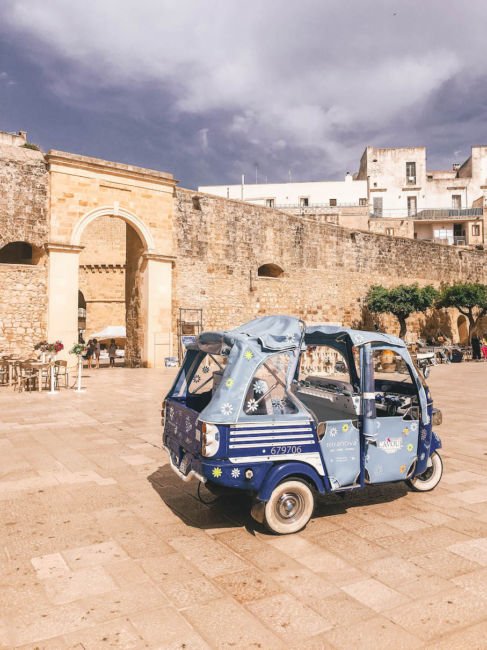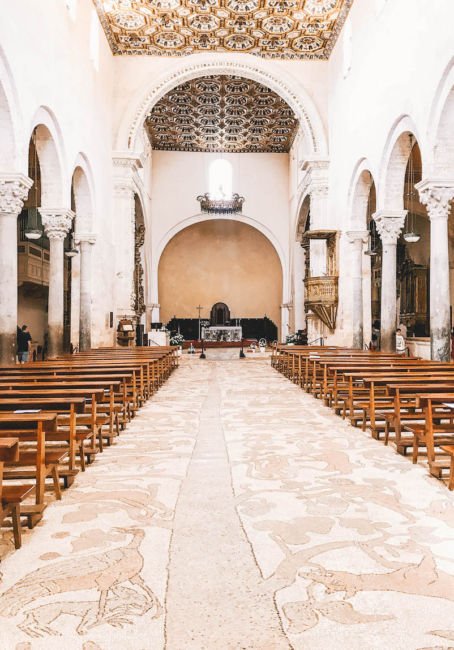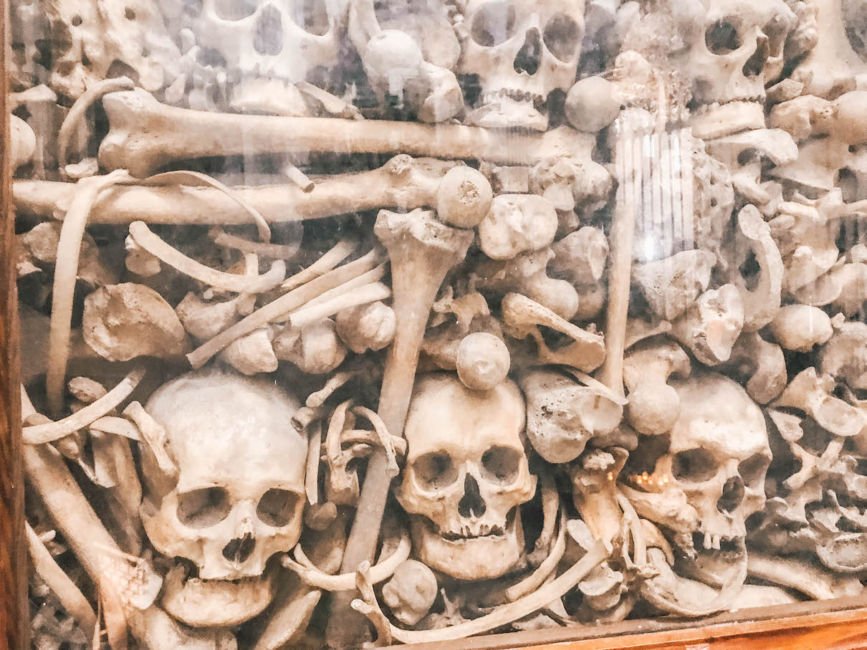It’s the most Eastern city in all of Italy and home to a historic lighthouse, ancient city walls, a beautiful castle, crystal clear swimming water and a mouthwatering selection of food – here’s why Otranto Puglia should be on your must-visit list this year.
Here are some of the top places we visited in Otranto and some great reasons to visit this beautiful area.
Things To Do in Otranto Puglia
This guide will detail the top things to do in Otranto, in the order that I visited them in June, as well as giving details on where we ate and where we stayed as well as some day trip ideas in case you would like to have Otranto as a base while you explore the stunning Puglia coastline on an epic road trip.
Punta Palascia Lighthouse
Otranto is where we started our Puglia road trip and I honestly think you couldn’t pick a better city to start your holiday in. We started our morning a little outside of town at the Punta Palascia Lighthouse, said to be the most Easterly point in all of Italy where, on a clear day, you can actually see across to Albania which is less than 50 miles away. It’s the meeting point of the Ionian Sea and the Adriatic Sea and is also only a stones throw away from the Greek island of Corfu.
This lighthouse, which only reopened to tourists about 10 years ago, is most popular on New Years Day, when people from all over Italy flock here to watch the very first sunrise and welcome in the new year. Some will even camp here overnight in anticipation.
Our Otranto guide, who spent many months at the lighthouse while studying, said he often spotted pods of dolphins and sometimes even whales just offshore.
The Lighthouse is situated inside the Natural Park of Costa Otranto and Santa Maria di Leuca, a beautiful natural park that covers an large area of Southern Puglia and protects the wild coastline, untouched beaches, unique cave systems and of course the important plant life. While I loved learning about all this from a guide, if you turn up by yourself, be on the look out for wild flowers and herbs such as wild basil and wild mint growing by the path down to the lighthouse museum.
Bauxite Cave of Otranto
Following our trip to the lighthouse, we stopped off at a very unusual place en route back to Otranto old town. Bauxite Cave of Otranto, we were told, was an old, disused quarry that’s now somewhat of a natural spring and bird reserve – as it’s where all the birds and small animals in the area come each evening to drink water and cool down.
This stop totally caught as by surprise and we couldn’t believe how unique the landscape was. The soil was a deep red, like the kind you would normally see in Australia or Arizona, and the water inside the pond was this very crazy green. Add to this the cool walk you can do around the old quarry and the endless sound of bugs, buzzing insects and chirping birds, and you have yourself a pretty unique Otranto attraction!
Admittedly it was blistering hot while we were looking around this area so we jumped in out Auto Rickshaw known here as an Ape (they’re similar to the ones used in India!) and headed into the old town to have lunch and check out the harbour area.
Otranto Puglia Old Town
It’s most likely due to my lack of research before doing this trip (if you’re reading this you won’t have that problem) but I was incredibly impressed by Otranto Old Town and a little shocked I had never heard of this beautiful destination before.
I fell instantly in love with tall city walls surrounding the city and the pretty, white-washed buildings that were hidden inside. I loved walking up the steep steps up the old city gate, walking through and inside into what felt like a hidden, protected city.
Even in June it didn’t feel too busy, and there were locals and holiday makers enjoying the late afternoon sun sipping on Spritz or having a late lunch.
The old town is full of cute boutique stores, with most items handmade or handcrafted by local artisans. You can’t help but fall in love with the achingly beautiful shop fronts with very colourful, miniature ceramics lined up outside. We quickly discovered that ceramics is a cherished art form down here, with many families continuing the tradition for hundreds of years.
The Castello of Otranto
You can’t visit Otranto without visiting the Castle of Otranto – not least because it’s smack bang in the middle of town and you can’t really explore the town without passing its towering walls.
Sadly we didn’t have enough time to explore the inside of the castle, but you can buy a ticket that allows you to see the chambers, halls & tunnels of the castle which dates back to the 15th century.
If you’re interested in history with a mix of gothic horror, I recommend reading “The Castle of Otranto” by Horace Walpole which is considered the first gothic novel to ever have been written – published over 250 years ago!
Otranto Harbour
What makes Otranto Puglia such a great destination to visit is the fact that you have a pretty town and pretty harbour all in one place. The crystal clear waters of the harbour and so clean that there’s even a small city beach ideal for families right in the centre of the old town.
There’s no need to take a bus or drive to beaches on the outskirts (although I highly recommend doing this too!) because the area by the town is so safe to swim in.
You can catch some beautiful sunsets, considering taking a boat trip and maybe seeing some dolphins, or just enjoying the view of the harbour from high ground while enjoying your third gelato of the day or some locally made wine.
Otranto “Cathedral of Skulls”
It’s easy to get “church fatigue” when visiting Italy as there are so many stunning churches and cathedrals that you’re almost expected to visit. While in most you’re told to “look up at the painted ceiling” or to “admire the frescoes” adorning the walls, Otranto Cathedral was unique in that the guide will tell you to “look down at your feet” as you’re welcomed into a world of tiled mosaics decorating the entire floor of the cathedral.
The mosaic, sometimes referred to as The Tree of life, depicts scenes from the Old Testament, fabled animals such as unicorns, scenes that depict the battle between good and evil and the journey of humans from the Fall to salvation. While this not be the correct word to describe a scene inside a church – the mismatch of scenes make it feel very “trippy” and somewhat confusing.
If the mosaic was the only interesting thing in the church, I would potentially forgive you for skipping it. But the most interesting, if not morbid, feature in this church is one that has garnered it titles such as “scariest church in the world“ by certain travel writers.
At the very front of the cathedral, behind the alter, you’ll discover a set of three glass displays that house the skulls of 800 martyrs who were murdered by the invading Turks in the 15th century for refusing to convert to Islam. The cathedral was turned into a mosque after the invasion and then shortly after turned back into a cathedral when the Italian’s once again took back their city.
Alongside the skulls and bones of the 800 decapitated martyrs, the cathedral also houses the rock that was used to kill each and every one of them – kept here as a constant reminder of the tragedy and grim times in Otranto’s history.
What to eat in Otranto
There are lots of great restaurants dotted around the old town, ideal for having a more leisurely lunch, but we decided to grab a quick bite in the form of a delicious and popular local delicacy – a traditional sandwich called a Puccia, packed with locally-sourced ingredients from Postofisso.
You can’t come to this part of Italy without eating your body weight in cheese – namely fresh Burrata cheese famous in Puglia. You can have it as a starter, ask for your sandwich to be filled with it or have it spread all over your oven-baked pizza.
Being so near the water, you can expect to find really great fish dishes on offer in the town as well as delicious seafood platters.
As in most towns in Italy, especially in summer, a Gelato a day should be a staple. We particularly loved the gelato from “Gelateria Cavour” and our guide told us that in Otranto they had some unique flavours only to be found in this area such as fig-flavoured gelato, wild mint or lemon ginger.
Worth a taste, but I’ll be sticking to chocolate from now on!
Fun Otranto Day trips
We didn’t actually stay the night in Otranto as we were on a tight schedule to see as much of Puglia as possible. We did, however, visit some pretty towns and cities very close to Otranto that I recommend you check out while in the region. Here’s my suggestions of the best Otranto day trips to take while on holiday in Puglia.
Discover the historic city of Lecce
Another city I had not heard of but totally fell for was Lecce. Like many of the towns in Puglia, it’s inside tall city walls and the buildings inside will have you drooling. It’s especially fun at night time as there’s an incredible atmosphere on the streets, an amazing selection of restaurants, bars and Aperitivo stops and often live music out on the piazza.
This town is also a great place for foodies and we did a foodie walking tour of the city, tasting all around us. You must stop off at the ancient Roman amphitheater that dates back as far as the 2nd Century and yet is still used today for concerts and events!
Other top sites to visit, that I promise will take your breath away, include the Basilica di Santa Croce, Lecce Cathedral and any shop selling wine or live oil – after all thats what this sixty is best know for!
Go swimming at Torre Sant’Andrea
This is one of the most famous coastal spots in all of Puglia and is just a short 20 minute drive from Otranto. You won’t be alone here, unless you come first thing in the morning, but even with the crowds it’s a must visit place in Puglia.
A dreamy swimming, boating and picnic stop – thrill seekers jump off the cliff face into the sparkling waters below. Admire the spectacular coastline consisting of sea arches, towers, sea stacks and cave systems – giving off Thailand vibes in the south of Italy!
Check out Brindisi City
Sadly we didn’t have too much time to visit Brindisi but as it will probably be the city you fly into when visiting Otranto, it’s worth putting a few hours aside to explore this historic port city – giving time to see the old port and city walls, the old castle and the monument to fallen Italian sailors.
From here it’s about a one hour drive to get to Otranto, without stopping.
Last updated on October 21st, 2024 at 07:57 pm



























